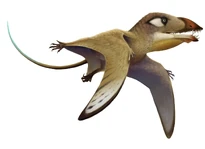
Illustration By Scott Reid
Caelestiventus is a pterosaur genus from the Late Triassic found in western North America. Caelestiventus is deemed to be important because it is the sole example of a desert-dwelling non-pterodactyloid pterosaur and is 65 million years older than other known desert-dwelling pterosaurs. Additionally, it shows that even the earliest pterosaurs were morphologically and ecologically diverse and that the Dimorphodontidae originated in the Triassic period.[1][2]
Discovery & Naming
The name meaning "heavenly wind". The type species, Caelestiventus hanseni, honors Robin Hansen, the Bureau of Land Management geologist (BLM), who facilitated access to the excavation site. Caelestiventus was recovered from the Saints & Sinners Quarry of northeastern Utah. The site was discovered in 2007 by Dan Chure and George Engelmann while working on the geology and paleontology of the fossilized dunes of the Nugget Sandstone. In 2015 the discovery of Caelestiventus was reported in the scientific literature.[3][4]
Description
Most Triassic pterosaurs are small in stature. Caelestiventus, however, is one of the largest; if not the largest, known Triassic pterosaurs, with a wingspan of at least 1.5 meters (4.9 ft) and a skull 17.8 cm (7.0 in) long (based on a complete mandible). These measurements are based on the only known specimen, which had not yet reached full maturity at the time of its death; a full-grown Caelestiventus would have been even larger.[5][6]
Unlike most Triassic pterosaur fossils which are often severely crushed, the bones of Caelestiventus are three-dimensional and relatively intact. This preservation provides insights into the delicate structures of skull bones, including pneumatic features such as foramina/fossae and internal chambers. Caelestiventus is known from a single individual (BYU 20707, in the Museum of Paleontology at Brigham Young University) that preserves much of the skull (skull cap, sides of the face, and a complete lower jaw (mandible) along with a single non-skull bone – the last finger bone at the end of the elongated fourth finger (manual digit IV 4) that supported the tip of the wing.[7][8][9]
The skull is well known. The laterally narrow and vertically deep skull is similar to that of Dimorphodon, with an enormous external naris (nostril) being the largest skull opening, and a large antorbital fenestra. Unlike most pterosaurs, the margin of the antorbital fenestra bears a remnant of an antorbital fossa. The skull roof has a median ridge as well as large ridges along the medial borders of the upper temporal fenestra that mark attachments for the muscle that closed the mandible. A prominent hood at the back of the skull, the nuchal crest, marks the attachment of large neck muscles. Sizable pneumatic openings on the skull top lead into small pneumatic chambers in the skull roof.[10][11]
The uncrushed skull cap permitted the first endocranial reconstruction in a Triassic pterosaur and shows the brain had large cerebral lobes, from which the optic lobes bulge, and small olfactory lobes. The lower portion of the front of the mandible has a keel. There are large pneumatic openings in the posterior mandible and the whole of the mandible is hollow and was likely air-filled (pneumatic). Caelestiventus is a heterodont, with three different tooth shapes - long fang-like spikes, large "leaf-shaped" blades, and tiny blades.[12]
There are two long, spike-shaped teeth near the front of each side of the lower jaws that were likely opposed by similar teeth at the tip of the skull snout (premaxilla). In the lower jaws, behind the fangs, there is a tooth gap (diastema) which is followed by 38 tiny teeth on each side of the lower jaw (mandibular ramus). Each upper jaw bone (maxilla) is armed with twelve large, blade-like, triangular teeth. Both sides of the maxillary teeth are strengthened by a central ridge and these teeth terminate in two tips (bicuspid).[13]
References
- ↑ https://www.nature.com/articles/s41559-018-0627-y
- ↑ https://giw.utahgeology.org/giw/index.php/GIW/article/view/8
- ↑ https://www.pteros.com/pterosaurs/caelestiventus.html
- ↑ https://www.nature.com/articles/s41559-018-0627-y
- ↑ http://www.sci-news.com/paleontology/caelestiventus-hanseni-triassic-pterosaur-06304.html
- ↑ https://www.researchgate.net/publication/326996450_Caelestiventus_hanseni_gen_et_sp_nov_extends_the_desert-dwelling_pterosaur_record_back_65_million_years
- ↑ https://www.uab.cat/web/news-detail/a-rare-triassic-pterosaur-discovered-in-utah-1345680342044.html?noticiaid=1345772338700
- ↑ http://prehistoricbeastoftheweek.blogspot.com/2018/10/caelestiventus-beast-of-week.html
- ↑ https://www.popsci.com/pterosaur-fossil-desert/
- ↑ https://svpow.com/2018/08/13/caelestiventus-hanseni-the-new-triassic-pterosaur-from-utah/
- ↑ https://www.ndtv.com/science/200-million-year-old-pterosaur-built-for-flying-1900074
- ↑ https://www.smithsonianmag.com/smart-news/rare-desert-pterosaur-fossil-discovered-utah-180969995/
- ↑ https://news.byu.edu/news/rare-triassic-pterosaur-discovered-byu-paleontologists